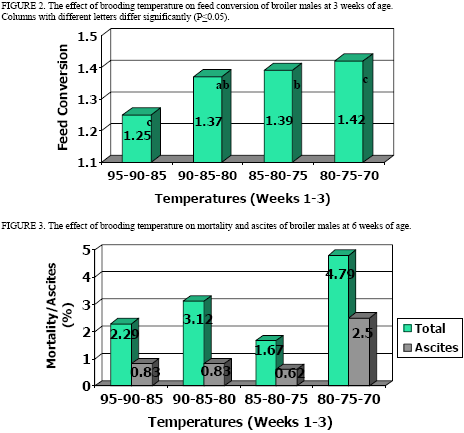



The Effect Of Cool Temperature On Broiler Performance
By Brian D. Fairchild, Extension Poultry Scientist and Mike Czarick, Biological Ag. Eng., University of Georgia - Gas prices this winter are at some of the highest that have ever been paid by broiler producers (currently about $1.60 per gallon of propane). As a result some broiler producers may be tempted to trim down house preheating times or lower house brooding temperatures to reduce fuel usage.
The money that will be saved on the fuel bill will not
compensate the money lost in bird performance. Research published in the Poultry
Science Journal in 1996 does a good job of summarizing how critical warm brooding
temperature is for getting chicks off to a good start.
A study conducted at the USDA Poultry Research laboratory in Starkville, MS brooded
groups of male chicks at 95°, 90°, 85° or 80°F during the first week. Temperatures were
dropped five degrees each week until the birds were three weeks of age after which
temperatures for all birds were held at 70°F until the end of the study at six weeks of age.
Chicks were raised in floor pens and were given unlimited access to feed and water.
At three weeks of age, body weight and feed conversion were better for the chicks
brooded at warmer temperatures (Figures 1 and 2). A point that should be considered is
the difference in air temperature and floor temperature. In the environmental chambers,
where these studies were conducted the floor temperature was close to the air
temperature. When brooding the floor temperature can have a dramatic impact on getting
chicks off to a good start. Floor temperatures should be monitored prior to chick
placement to ensure that they are at least 90°F. Since chicks cannot regulate their body
temperatures until around 10 to 14 days of age, cool floor temperatures will reduce body
temperatures and have negative impacts on body weight gains and feed conversion.
The
birds will not compensate for this reduced weight gain and lower market weights will
result. If the body weight and feed conversion data are not enough to demonstrate the
benefits of using proper brooding temperatures, the differences in mortality and ascites
should help. Birds at cooler brooding temperatures had double the mortality and more
than 3 times the amount of ascites (Figure 3).


So if you are worried about fuel costs this winter, do not be persuaded to try to save money by reducing house temperature. Instead, focus on tightening up the broiler house, make sure that fan shutters are closing properly and install circulation fans. For additional information on minimizing heating costs this winter, read the September 2004 Poultry Housing Tip that can be found at www.poultryventilation.com.
Reference:
Deaton, J. W., S. L. Branton, J. D. Simmons and B. D. Lott, 1996. The effect of brooding temperature on
broiler performance. Poultry Science 75:1217:1220.
Source: University of Georgia - Poultry Science - January 2006









